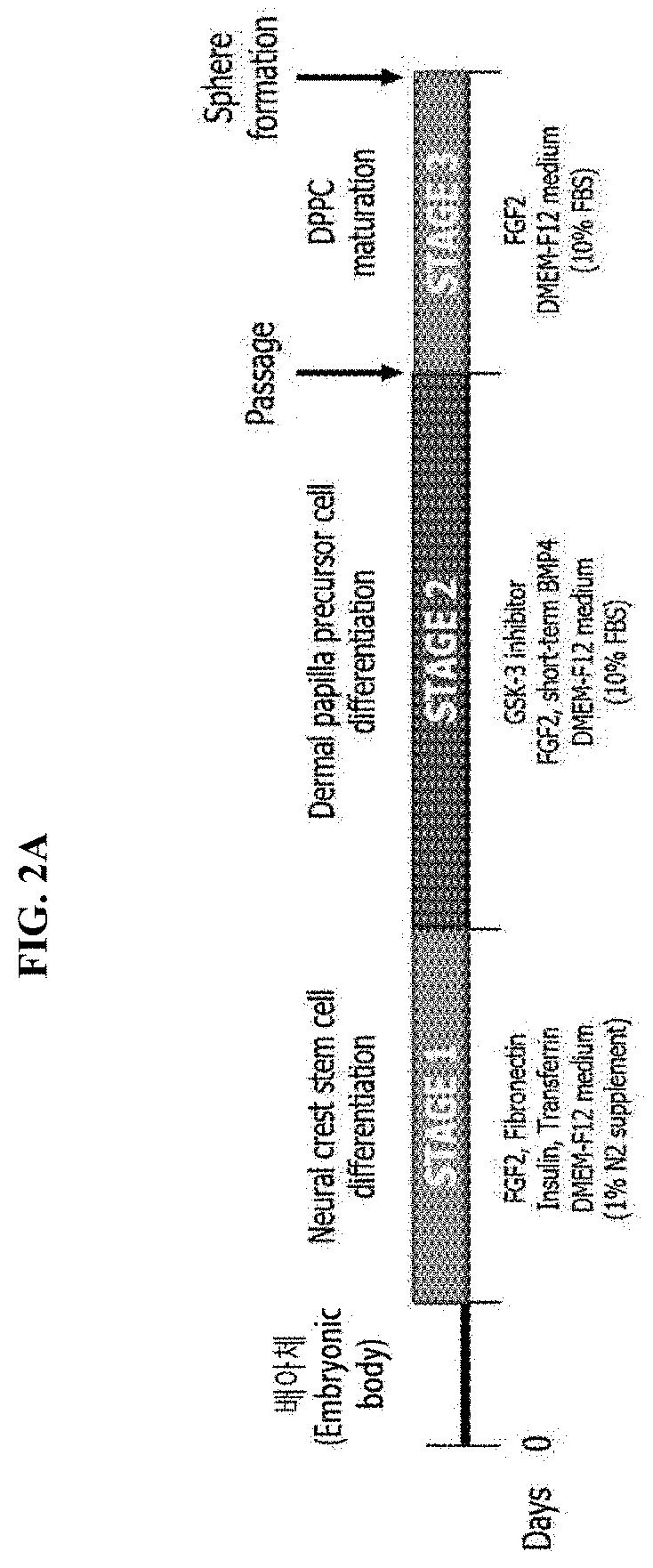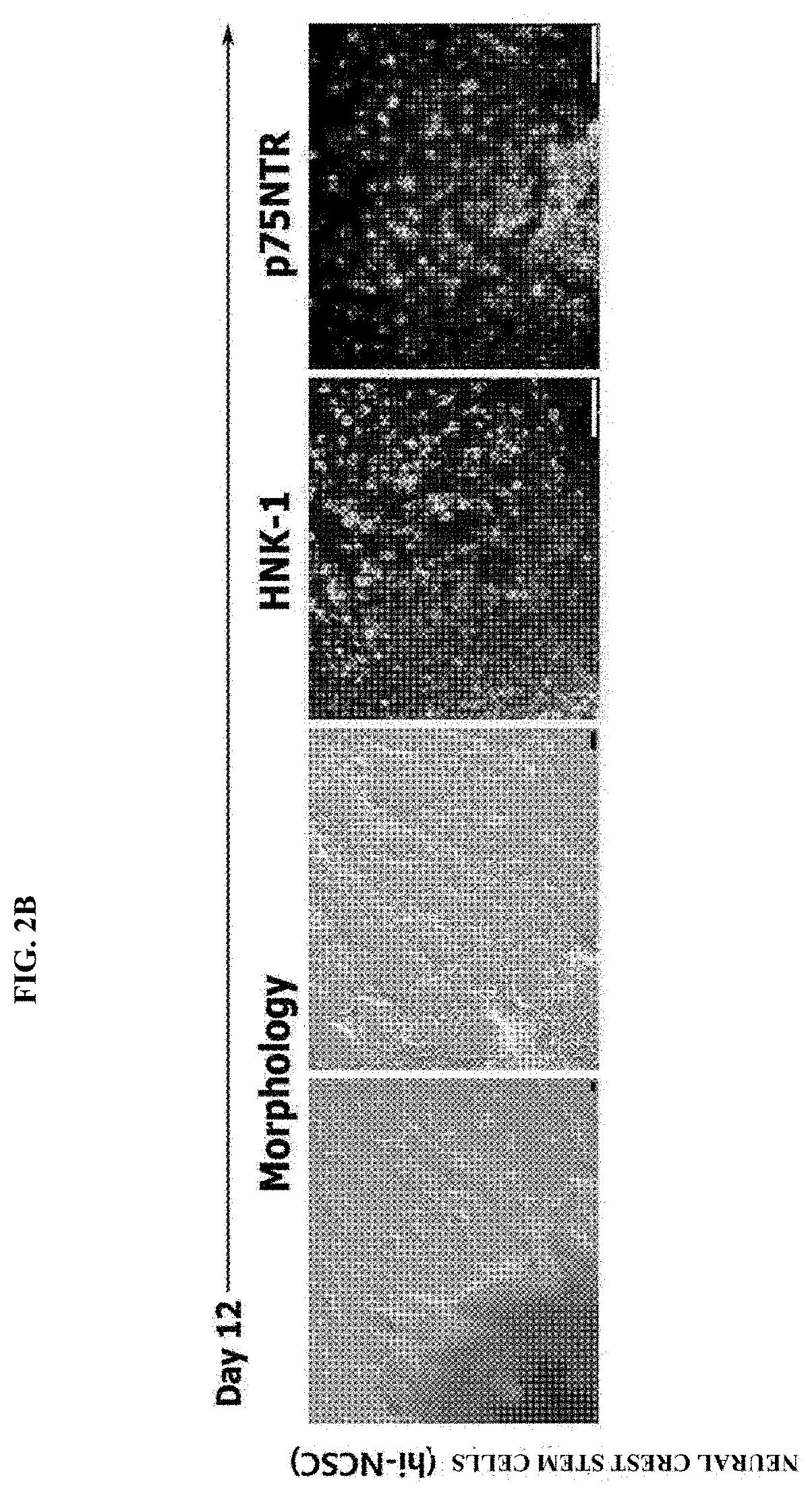Method of differentiation of human induced pluripotent stem cell to dermal papilla precursor cell and use thereof
a technology precursor cells, which is applied in the field of differentiation of human induced pluripotent stem cells to dermal papilla precursor cells, can solve the problems of insufficient number of available hair follicles, cells rapidly lose hair follicle-forming ability, and patients with male hair loss or childhood cancer survivors have a limitation of autologous hair follicle transplantation, etc., to achieve effective use and induce the neo
- Summary
- Abstract
- Description
- Claims
- Application Information
AI Technical Summary
Benefits of technology
Problems solved by technology
Method used
Image
Examples
example 1
Experiment Preparation and Experimental Method
1-1. Production of Induced Pluripotent Stem Cells from Human Skin Fibroblasts
[0106]Human skin fibroblasts (ATCC PCS-201-012) were subcultured three times, and then reprogramming factors OCT4, SOX2, KLF4, and c-MYC were transduced using a retrovirus. At 24 hours after transduction, a virus-containing medium was replaced with a fresh growth medium, and two weeks after transduction, induced pluripotent stem cell (iPSC)-like colonies were observed in the transduced human skin fibroblasts. The colonies were picked up and transferred to a new STO feeder, and after 2 days of colony attachment, the culture medium was replaced with a fresh embryonic stem cell culture medium supplemented with 10 ng / ml of bFGF.
[0107]Subsequently, the embryonic stem cell culture medium was replaced daily, the colonies were incubated under 5% O2 conditions on a mitomycin C-inactivated mouse STO feeder in a human embryonic stem cell medium containing DMEM / F12 Glutamax...
example 2
Expression Analysis of SDC1 and CD133 in Human Hair Follicle Placode Stage In Vivo
[0151]To induce human hair follicle neogenesis, the inventors of the present invention established a simple strategy to mimic the biological state of the hair placode stage based on the morphogenesis of hair follicles occurring in human embryos. More specifically, it was focused to obtain dermal papilla precursor cells in the dermis and skin fibroblasts at a hair follicle placode stage.
[0152]To monitor the differentiation process, specific surface markers for human dermal papilla precursor cells were needed. Syndecan-1 (SDC1) is a well-known surface marker that is strongly expressed in the scalp of human fetuses not only in mouse skin but also in the hair follicle placode stage, and is also known as a human dermal papilla signature gene. Meanwhile, CD133 was originally known as a surface marker of hair-derived dermal papilla cells in mice, but human dermal papilla cells have been reported to have no ex...
example 3
Preparation of Differentiation Medium of Human Dermal Papilla Precursor Cells
[0154](1) Production of Human Induced Pluripotent Stem Cells (hiPSC)
[0155]In accordance with known methods (Cell 131, 861-872.), the inventors of the present invention produced induced pluripotent stem cells (hiPSCs) from isolated adult dermal fibroblasts using four genes called Yamanaka factors, i.e., octamer-binding transcription factor 4 (OCT4), sex determining region Y-box 2 (SOX2), Kruppel-like factor 4 (KLF4), and c-MYC. Induced pluripotent stem cell clones dedifferentiated using the method exhibited human embryonic stem cell (hESC) morphology and a high level of alkaline phosphatase (ALP) activity, and were confirmed to express various pluripotent markers including surface antigen stage-specific embryonic antigen 4 (SSEA4) as well as OCT3 / 4 and NANOG. It was also confirmed through quantitative real-time polymerase chain reaction (qPCR) that the expression of endogenous sternness genes including OCT3 / ...
PUM
| Property | Measurement | Unit |
|---|---|---|
| concentration | aaaaa | aaaaa |
| concentration | aaaaa | aaaaa |
| time | aaaaa | aaaaa |
Abstract
Description
Claims
Application Information
 Login to View More
Login to View More - R&D
- Intellectual Property
- Life Sciences
- Materials
- Tech Scout
- Unparalleled Data Quality
- Higher Quality Content
- 60% Fewer Hallucinations
Browse by: Latest US Patents, China's latest patents, Technical Efficacy Thesaurus, Application Domain, Technology Topic, Popular Technical Reports.
© 2025 PatSnap. All rights reserved.Legal|Privacy policy|Modern Slavery Act Transparency Statement|Sitemap|About US| Contact US: help@patsnap.com



